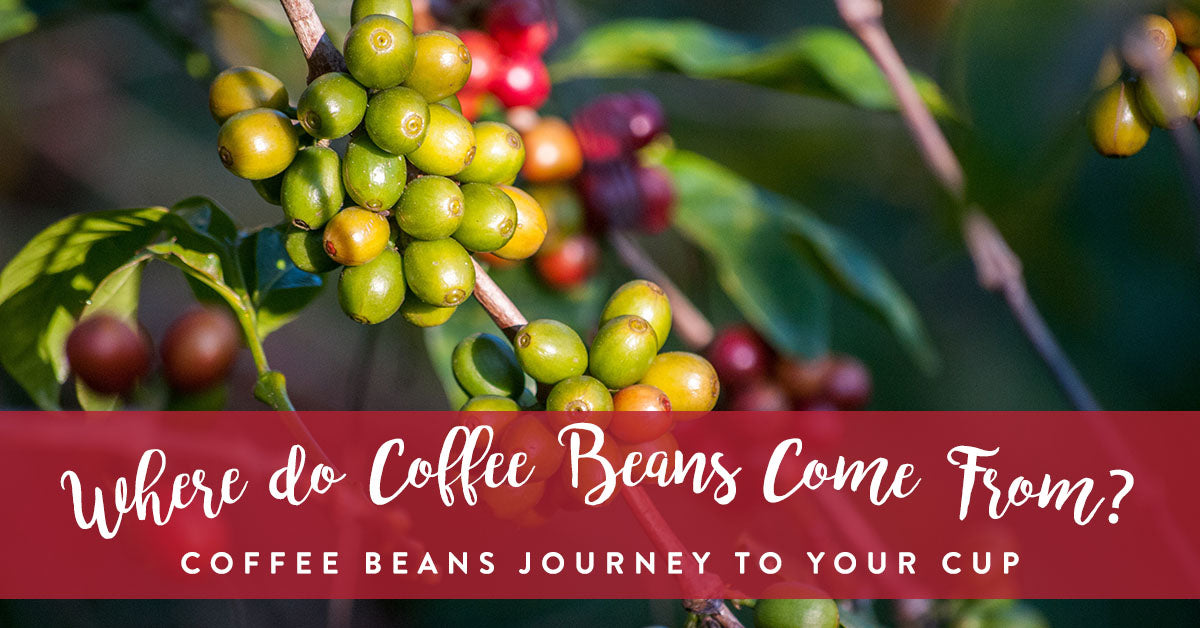
Where do coffee beans come from?
The coffee tree is a tropical evergreen shrub (genus Coffea) that grows in a sunny equatorial belt around the world. This belt is 1000 miles wide and runs between the Tropics of Cancer and Capricorn. The two most commercially important species grown are varieties of Coffea arabica (Arabicas) and Coffea canephora (Robustas). Through the years many have tried to cultivate these shrubs outside of this warm zone, but without success.
The average Arabica plant is a large bush with dark-green oval leaves. The fruits, or cherries, are rounded and mature in 7 to 9 months. They usually contain two flat seeds, the coffee beans. When only one bean develops it is called a peaberry. Robusta is a robust shrub, or small tree, that grows up to 10 metres high. The fruits are rounded and take up to 11 months to mature. The seeds are oval in shape and smaller than Arabica seeds.
With the exception of some shade grown varieties, most coffee plants produce their cherries in hot, sunny regions with generous rainfall. The average temperatures for these main varieties range between 15 to 24ºC for Arabica coffee and 24 to 30ºC for Robusta, which can flourish in hotter, harsher conditions. Coffee needs an annual rainfall of 1500 to 3000 mm, with Arabica needing less than other species. Whereas Robusta coffee can be grown between sea-level and about 800 metres, Arabica does best at higher altitudes and is often grown in hilly areas.
As a general rule of thumb, coffee grown at higher elevations in these tropical areas produces some of the finest coffees.?? Think of the rugged mountains of Colombia and Guatemala, or the volcanic slopes of Java and Sumatra. These high places are known for their full-flavoured, robust coffee. In large part this is because Arabica plants are best suited to high altitude and are generally considered to produce higher quality, better tasting, coffee beans. But also, higher altitude farmers employee less intensive production methods, including hand-picking and sun-drying the cherries, which maximises the flavour in their Speciality Beans.
Coffees grown at lower altitudes can also be exceptional, though the conditions at lower elevations are often less than ideal. Beans can over-ripen, or receive too much moisture. And, because the trees produce beans non-stop, the flavour and quality can be diluted. Low altitude coffees, which are often of the Robusta variety, are best suited for mass production, where low elevation coffee plantations are easier and more efficient to farm. These beans, including those grown in the lowlands of countries like Vietnam, tend to end up in mass produced commercial coffee, including Instant Coffee.
Over 75 countries grow coffee and the world's best farmers cultivate Specialty Beans, which is an industry term for the highest graded coffee beans. These farmers are often from countries that are not the largest volume producers of beans, but for many coffee fans, they are the best. Beans from Jamaica's Blue Mountain are a good example. Grown in very small quantities, their exclusivity makes them very expensive and cherished by fans for their distinct but subtle flavour.
Most independent coffee roasters in the UK, including Spiller & Tait, roast mainly high grade Speciality Beans. However, lower quality Robusta beans have started to feature again in coffee blends as they have a higher caffeine content and flavour intensity, which suits the milk-based drinks which are currently very popular with coffee drinkers. Our Classic Italian Blend is a good example of a Speciality Blend which features a splash of Robusta beans with the mainly Arabica blend.
Learn more about the flavour variations derived from the different coffee growing regions here.

